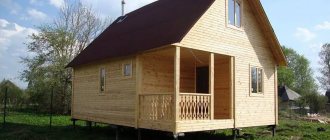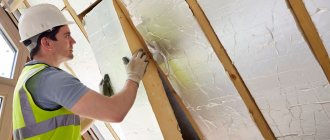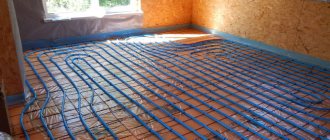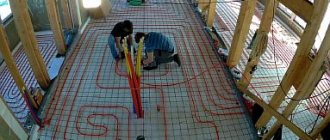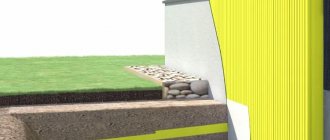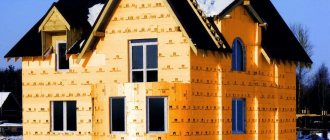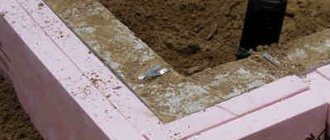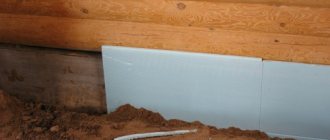If you decide to build a frame house for yourself, then its insulation is a very important aspect. It is necessary to decide on the material and methods of insulation. In order for the home to be warm and cozy during the cold season, in addition to the walls, the floor insulation in the frame house is required. In this article we will try to reveal some of the nuances and advantages of this or that material, as well as methods of laying and thermal insulation of the floor in the building being built.
What materials to install the floor from?
Before you carry out thermal insulation of the floor in the frame on your own, you need to find out what materials the floor sandwich in the proposed structure will be made from. Before deciding on the insulation material, you need to take into account the region in which the structure will be built, as well as calculate the expected load on the structure, in addition, determine the purpose of certain rooms inside the room.
The generally accepted material for making logs is coniferous wood, which is characterized by its low cost, long service life, and most importantly, reliability. Although if you use oak wood for logs, the service life will be much longer, but the material is also an order of magnitude more expensive.
Proper floor insulation involves the use of high-quality material for a frame house. Before purchasing lumber, it is imperative to make sure that the wood is properly dried; it is better that this is done in production, since if the material is damp, it can twist during operation, which will significantly affect the quality of the entire structure.
Video description
About ecowool insulation of the second floor of a frame house in the following video:
- Wet-glue method . It is used if it is necessary to insulate a large surface area or the project does not provide for cladding. In this case, water is added to ecowool if untreated wood is to be protected; or PVA glue, which increases the adhesive (adhesive) properties of the mixture. Can also be applied using a blow molding machine.
- Liquid plaster (liquid wallpaper) . A type of wet method, applied using the trowel method. If the layer will serve not only as insulation, but also as a cladding, it is possible to add dyes.
Laying floors in a frame house
Any construction begins with the need to carry out all the preparatory work. All lumber that will be used in the construction of the structure must be impregnated with the required antiseptics and fire retardants. This will help protect the structure from possible fire, and will also repel parasites and rodents.
In the case of using a columnar foundation, the preparatory work involves preparing the pillars on which construction will be carried out.
If the choice fell on screw piles as a foundation, then the preparatory work will begin with the very screwing of these same piles.
Use of logs in frame construction
Insulation of the floor in a frame house on a pile-screw foundation begins with the fact that it is necessary to tie this very foundation. This will allow the floor and foundation to be connected into one; such a structure will be much stronger and more reliable. Tying is done in the following order:
- A board for the bottom trim is laid out on a pile-screw base;
- The strapping beams are attached to each other at the corners of the building and are additionally fixed with staples;
- The timber is secured to the ends of the pile-screw foundation using bolts;
- After all this is done, you can immediately begin installing the logs. As a rule, a board with a section of 100x50 mm is used for this. The size is determined by the expected load on the floor covering. The logs are mounted using nails on the foundation frame. The logs must be impregnated with fire-fighting and antiseptic solutions.
Conventional frame construction involves installing a subfloor at the initial stage. Only after this can you begin installing partitions and walls. There is no need to carry out these works, and they are carried out only at the request of the owner or in accordance with architectural drawings.
Rough floor
Insulating the floor in a frame house involves stuffing wooden slats in the spaces between the joists, onto which sheets of plywood or specialized moisture-resistant chipboards will subsequently be mounted. In order to maintain the height of the joists, which is necessary in order to place insulation of sufficient thickness between them, the rough covering can be mounted directly on the underside of the joists, in which case support slats are not required. When installing a subfloor in a frame frame, you should remember some nuances:
- Sheets of the rough coating are mounted in a checkerboard pattern;
- The thickness of the slabs or plywood to be used is determined depending on the spacing between the joists;
- The sheets are installed using specialized glue and self-tapping screws, this will prevent the floor from creaking when walking on it during operation;
- Fastening is carried out in the central part and along the edges, screws are screwed in at a distance of 150 mm from each other;
- When installing plywood, it is necessary to leave a gap not exceeding 3 mm between the sheets. To ensure that this gap is the same everywhere, you can use nails or screws of the required diameter. Upon completion of installation, they must be carefully removed.
How to insulate the floor in a house on stilts
In order for insulation to be carried out according to all the rules, you need to know exactly what the floor sandwich in the frame will consist of. The floor in a frame house usually consists of:
- Wood flooring;
- Vapor barrier layer;
- Insulation layer;
- Windproof membranes or films;
- Subfloor.
The entire structure of the frame structure is installed on floor joists, which, in turn, are installed on the foundation and on the frame. Usually the logs are equal in height to the floor sandwich, frame on stilts.
In harsh climatic conditions in a house on stilts, an additional layer of insulation is required; it must be installed even if the height of the logs does not allow for its installation.
The subfloor serves as a base, a kind of support for the installation of subsequent layers of the frame floor panel sandwich. This measure makes it possible to install the floor both from wooden boards and from other sheet material. The scheme for insulating the subfloor of a frame house involves fixing it to the underside of the joists, thus creating unique wooden containers, which, for the purpose of insulation, will be filled with heat-insulating material.
In order to prevent hot or cold air from entering the structure, a wind protection layer is located in the niches between the logs. It is also necessary to install a vapor barrier layer; it is better, of course, to use materials that prevent the penetration of steam, but do not interfere with air circulation, these include diffuse membranes.
The vapor barrier layer must be laid overlapping, with a covering of the lower layer of at least 100 mm. If a film is used for vapor barrier purposes, its thickness should be more than 300 microns; reinforced film is better suited for this. After this, the floor in the frame house is insulated by laying insulation.
After the insulation, we again lay a layer of vapor barrier. The need to lay this layer is very obvious; as a rule, with high humidity indoors, steam, in any case, will reach the sandwich floor of the frame, which will significantly affect the quality characteristics for the worse.
Installation of wooden flooring is the final process in installing the floor of a frame building. In addition to the base for decorative covering, such flooring will protect the elements of the floor sandwich from mechanical damage.
We insulate the floor in the frame
Insulation is an integral material when installing the floor of a frame house, which, in turn, will allow you to establish an optimal microclimate indoors. If insulation is carried out using foam plastic or mineral wool, then it is more constructive to use cross-laying of the heat insulator.
Insulation with mineral wool
Mineral wool is a more versatile insulation material than others, since in addition to the fact that this material provides unique thermal insulation, this element also copes excellently with soundproofing tasks.
This material, as insulation, excellently resists the formation of fungus and is not susceptible to fire. In addition, mineral wool prevents rodents from forming nests in walls and floors, since the sharp fibers of the insulation repel them.
A frame house and floor insulation in it can be viewed in a training video in which this process is shown step by step from start to finish. Installation of mineral wool as insulation is carried out in protective clothing; compliance with this condition is mandatory, since mineral wool fibers negatively affect the human respiratory system, as well as the skin.
Mineral wool must be properly dried, since when the material is damp, the performance characteristics are much lower.
Polystyrene foam as insulation
The use of expanded polystyrene as insulation for a frame house is not entirely advisable for environmental reasons. This material contains a large number of harmful impurities. Among the positive characteristics, excellent sound and moisture insulation data should be noted.
In addition to environmental disadvantages, one should also note the predilection of rodents for building their nests in wall cavities insulated with foam plastic, and at high temperatures the material melts and releases toxic substances.
What to choose
All the described materials have their advantages and disadvantages, however, when choosing, it is also necessary to take into account the characteristics of the insulated room. Complexity of installation, availability of appropriate qualified workers. Under no circumstances should you violate the technology for laying this or that material, as this can lead to a lack of heat in your home, and identifying and eliminating such defects may require much greater resources.
If your choice is between basalt blocks and ecowool, take into account the availability of qualified installers with special equipment; if you don’t find them, it’s better to use a simpler material - basalt blocks.
Use of sawdust and expanded clay for insulation
First you need to understand what expanded clay is. This is a raw material created by burning shale, subsequently forming pellets with low weight. This type of insulation also has excellent sound and heat insulation properties.
Insulating the walls, floor and ceiling of a frame house with expanded clay is the simplest method of thermal insulation; to do this, simply pour a layer of expanded clay on top of the windproof layer and level it well, aligning the lag along the edge. This type of insulation does not need to be adjusted to size, this material does not require any additional fastening, and also copes excellently with minor unexpected gaps and cracks.
When using sawdust as insulation, all work is carried out according to the same principle as with expanded clay, with one minor but very important difference - the raw materials for the insulation must be treated with protective solutions that prevent the occurrence of fungi, rodents and possible fire.
The importance of high-quality vapor barrier and wind protection of insulation
In order for mineral wool insulation to cope with its duties perfectly, they need well-designed steam, water and wind insulation:
- Vapor barrier . Serves as a barrier to moisture coming from the room. In the absence of such a protective layer, mineral wool absorbs moisture, and its ability to retain heat drops sharply.
- Hydrowind protection . Both a windbreaker worn over a sweater and a protective membrane on the outside of the wall help retain heat. This protective material has a complex multi-layer structure - it not only retains heat, but also allows water vapor to pass out, while at the same time preventing atmospheric moisture from penetrating inside.
Modern protective membranes are capable of maximally insulating the insulation (and, therefore, the wall structure), which cannot be said about polyethylene film, which thrifty (or not familiar with physics) builders strive to use. Polyethylene will inevitably create the effect of a thermos inside the wall without the possibility of ventilation, which leads to damage to the insulating layer throughout the entire volume of the walls.
Wind protection of a frame house is an essential component of construction Source seattlehelpers.org
Using penofol for insulation
How to efficiently insulate the floor in a frame house using an inexpensive material that meets all the requirements? Penofol is a heat-insulating material made of polyethylene, foamed in a special way, which is subsequently covered with aluminum foil on one or both sides. This type of insulation is manufactured in rolls with a thickness from 0.5 mm to 10 mm. Penofol is fireproof, hydrophobic and environmentally friendly material, which makes it very attractive among consumers.
It is recommended to use it in combination with other materials that provide hydro-, wind- and vapor barrier.
Park or Rockwool
Many developers are trying to determine which thermal insulation - Parok or Rockwool - has the best technical characteristics. If many user reviews on the Internet point to Parok, then in our article we will provide a comparison of these two products.
| Characteristic | Park | Rockwool |
| Coefficient of thermal conductivity | 0.036 W/μ | 0.036 W/μ |
| Vapor permeability indicator | 0.55 mg/mchpa | 0.3 mg/mchpa |
| Maximum Density | 35 kg/m³: | 35 kg/m³: |
| Fire resistance | Incombustible | Incombustible |
| Overall dimensions of products | 1.2*0.6 m | 1*0.6m |
| Total area of slabs in one package | 10.08m2 | 6m2 |
| Packaging cost for a product thickness of 5 centimeters | 800 rubles | 550 rubles |
| Price m3 of thermal insulation | 1600 rub. | 1800 rub. |
Note! Despite similar technical characteristics, Parok mineral wool does not tend to shrink, which cannot be said about Rockwool thermal insulation. In addition, such material has a lower cost.
